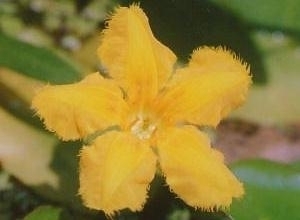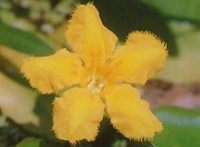Floating Yellow Heart (Nymphoidas Peltada) Discontinued
Key identifying traits:
Bright yellow, 5-petaled flowers, one inch in diameter; two to five flowers per stalk.
The flower petals are distinctively fringed.
Long stalked, heart shaped leaves with wavy margins. The leaf undersides are purplish.
Dense mats are formed by these heart shaped leaves floating on the surface of the water.
Growth Habit:
Like other floating leaved plants, yellow floating heart grows in dense patches, excluding native species and even creating stagnant areas with low oxygen levels underneath the floating mats. These mats make it difficult to fish, water ski, swim, or even paddle a canoe through. It prefers to grow in slow moving rivers, lakes, reservoirs, and ponds.
Floating water heart reproduces by water dispersed seeds and by new stolens. Broken off leaves with part of a stem will also form new plants.
Reproduction
N. peltata reproduces by both vegetative and sexual methods.
· Each plant produces one 2.5 cm long fruit that contains numerous seeds.
· Fragments of N. peltata containing leaves and a portion of the stem, are capable of sinking and
developing into new plants.
Impacts and Threats Posed by Yellow Floating Heart
N. peltata is a very aggressive plant that is capable of rapid growth and spread. N. peltata can
displace native species, reduce biodiversity, limit recreation, diminish aesthetic value, and decrease
water quality and flow.
· Dense floating mats of Yellow Floating Heart can form on the water’s surface, restricting light to
the complete exclusion of other native plants, and decreasing the air exchange between the
water’s surface and the atmosphere.
· Thick floating mats can entirely prevent fishing, boating, swimming and other activities and the
loss of recreational and aesthetic value can cause a decline in surrounding lake property value.
· Algae, a major component of the base of the food chain, can be shaded out by dense mats of
Yellow Floating Heart. The resulting decline in algae can disrupt the entire food web in a lake.
· N. peltata may form dense single species stands that often do not provide ideal habitat or food for
native wildlife and may limit access to the water for some species. These native wildlife
populations may be forced to relocate or perish, ultimately resulting in a loss of biodiversity and a
disruption in the balance of the ecosystem.
· Sediment levels increase with increasing N. peltata abundance
Management Methods
Management methods currently include mechanical removal and herbicide application.
· Harvesting can greatly reduce the biomass in a water body, but this technique requires frequent
repetition and is labor intensive.
· Some herbicides, including aquatic glyphosate show promising results, however, herbicides
require permits, must be applied by a licensed applicator and may impact non-target native plants
or animals
Yellow Floating Heart can occasionally be confused with native Yellow Water Lilly (Nuphar variegatum) and native Little Floating Heart (Nymphoides cordata). Yellow Water Lilly has very large leaves (6-8 inches) and button or cup-like flowers. Little Floating Heart has root bunches located on the stem just beneath the waters surface and lacks fringes on the leaf margins.
View the PDF for complete operating instructions.
Reviews




